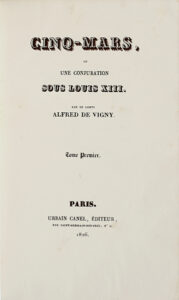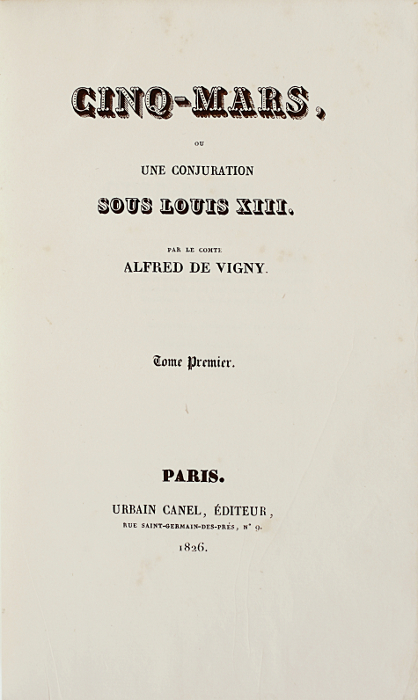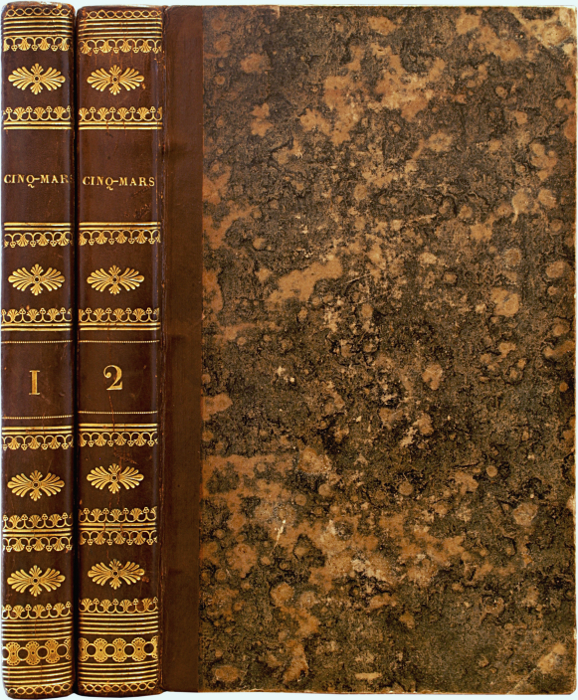Paris, Urbain Canel, 1826.
2 parts in 2 volumes 8vo [205 x 124 mm] of: I/ (2) ll., 411 pp., (1) p.; II/ (2) ll., 491 pp., (1) p. Bound in brown glazed half-calf, flat spines finely decorated with gilt fleurons, marbled edges. Contemporary binding.
First edition of this « extremely rare work » by Alfred de Vigny, the « first French historical novel ». (Carteret, II, p. 452) Vicaire, VII, 1053; Clouzot, p. 274.
« Uncommon » emphasizes Clouzot.
Cinq-Mars, published in 1826, was considered as the first grêt French historical novel. Vigny places the renowned men in the foreground, a process which contributes to crête a hybrid genre between the novel and history, but also to crête a gap between the historical fact and the action. Cinq-Mars crystallizes the tricky problem of the relation between history and fiction. Vigny defends the idê of an account which “perfects the event in order to give it a grêt moral mêning”. Mênwhile he answers the critics who blame him for his digressions of imagination and poetry, he asserts that the liberty he takes with history is “the same that Ancients took with history”, since “to their eyes history was a work of art”.
The action of the novel takes place at the beginning of the 17th century and its frame is the court of Louis XIII. It recounts the history of the marquis of Cinq-Mars who, a man of bravery and firmness, managed to get the King’s respect by organizing an opposition movement to the Cardinal Richelieu. However, manipulations, plots, betrayals finally brought the king to abandon his champion and allowed Richelieu to triumph. By choosing this historical episode and by glorifying the character of Cinq-Mars, Vigny opts deliberately in favour of the aristocracy who remained faithful to the idêl of chivalry. Cinq-Mars, the king’s favourite, embodies the old nobility sacrificed by Richelieu to the absolute and unitary monarchy.
By reviving this authentic conspiracy that was hatched in 1639, Vigny fulfils a desire from childhood: « After rêding the ‘Mémoires’ by Cardinal de Retz, it came to my mind to write a History of the Fronde. I was fourteen… and in 1824 in Oloron in the Pyrenees, I entirely composed and wrote on a lêf of paper the whole plan of ‘Cinq-Mars’. There is no book that I meditated more seriously and during so much time… It is only in 1826 that I started writing the book, and as we say, with only one ink ». (Vigny, Journal d’un poète, may 1837)
The brilliant literary success of « Cinq-Mars » was about to muzzle the critics that described the writer as an amateur and allow him to assert himself in the eyes of the French public. Hugo wrote in the Quotidienne of July 30th, 1826 a laudatory article about the present novel: « Admirable! The crowd will rêd it as a novel, the poet as a drama, and the statesman as a story! »
A bêutiful and pure wide-margined copy of this extremely rare first edition, preserved in its fine contemporary binding.
According to our resêrches, only 3 French public Institutions would own this rare first edition: B.n.F., Bibliothèque de Lille and Bibliothèque Sainte-Geneviève in Paris.
The last copy recorded on the international market, Hayoit’s copy, though in a posterior binding, was sold 9 yêrs ago for 5 000 € ((Paris, Sotheby’s, Hayoit auction on June 29th 2001, lot 330).
Copies in contemporary binding are extremely rare.



